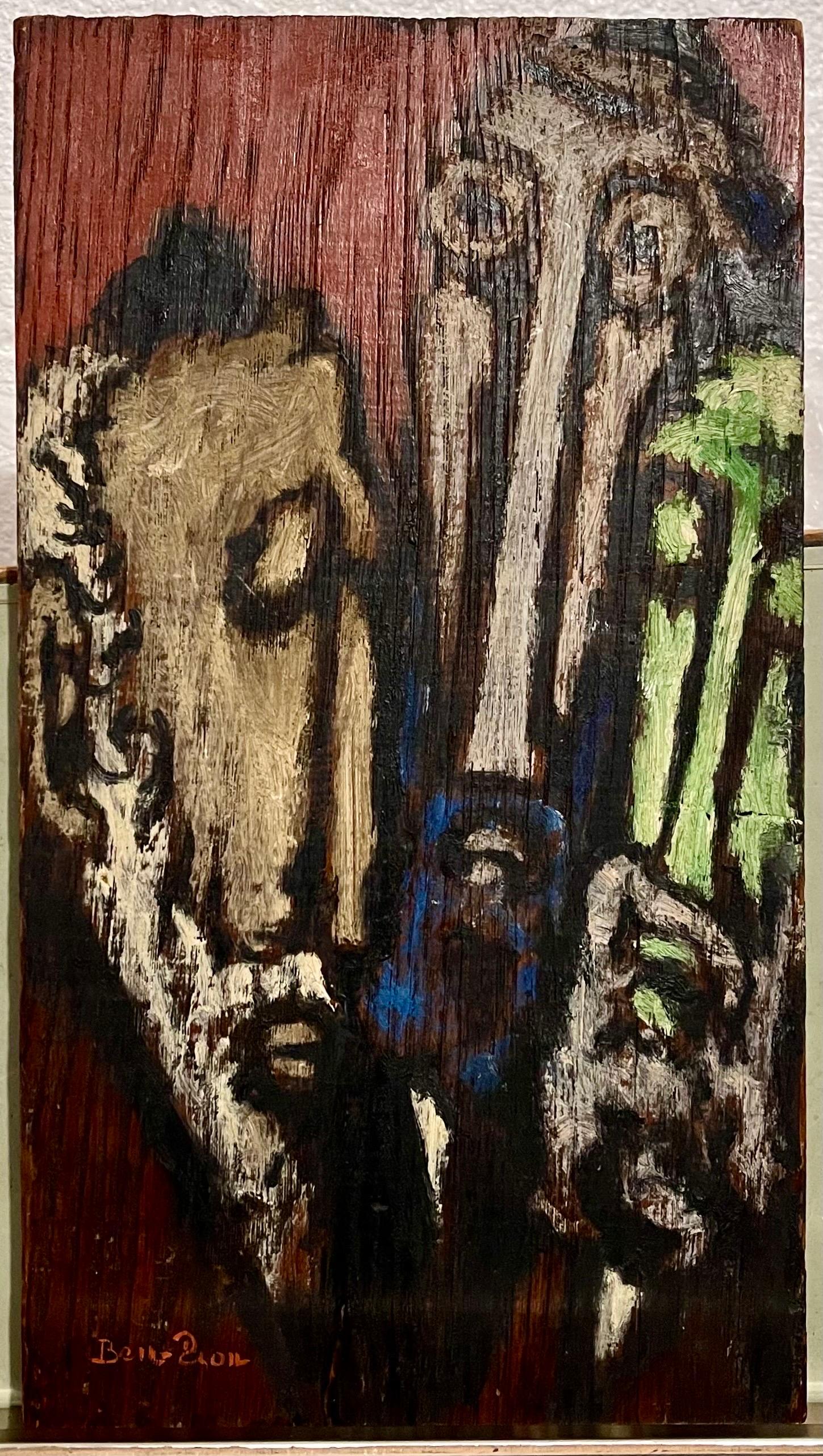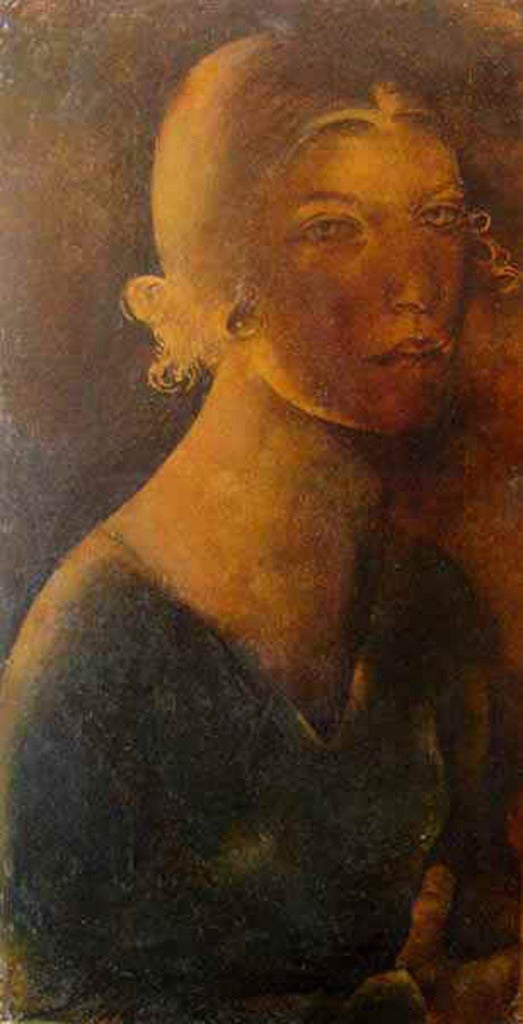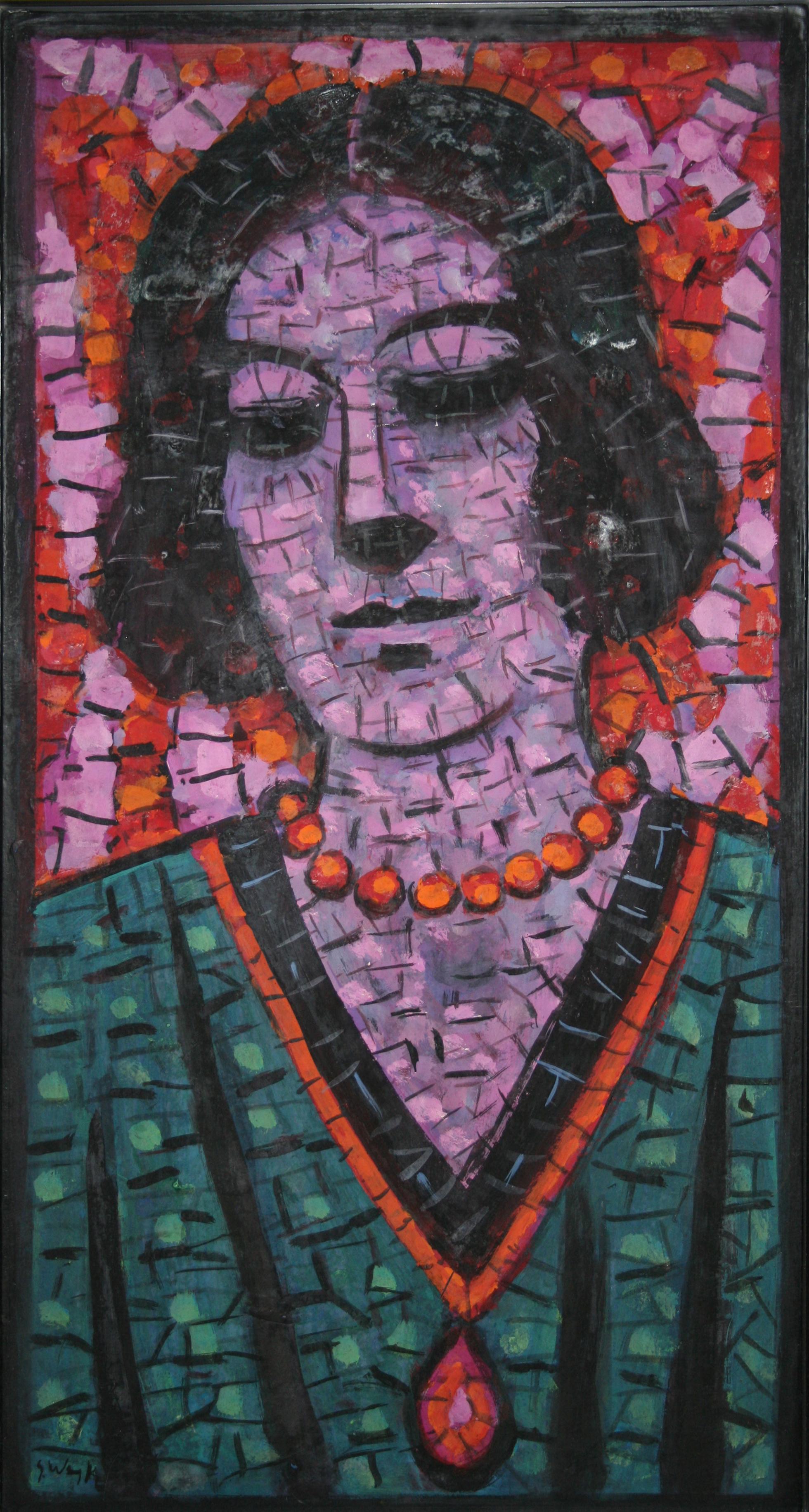Items Similar to Devotion
Want more images or videos?
Request additional images or videos from the seller
1 of 4
Erich WaskeDevotion1967
1967
About the Item
Deling with the work of Erich Waske today, one encounters first of all a number of reasons why this outstanding artist has fallen into such undeserved oblivion. In addition to the destruction of his studio and thus much of the previous life’s work in the Second World War and his unadapted personality, this includes the careless handling of his own estate. While Waske is almost unknown in the public perception of the art world, he was considered during his lifetime as one of the most important representatives of German Expressionism, which was part of the extended “Brücke” artist collective. Two monographs were published as early as 1921, he exhibited with Schmidt-Rottluff, Kandinsky and Pechstein and also had their – already then very high – price level. This fact makes Erich Waske a veritable discovery of classical modernism in Germany.
The predominant expressive quality of the work of Erich Waske lies in his sovereign handling of the color, which earned him the nickname “Symphonist of Colours”. The works of the – largely lost – early work are characterized by a gestural ductus; Over time, the color palette is reduced but more powerful, flat and richer in contrast. With a palette of mostly two or three colors – often violet, orange and blue – a maximum effect is attained that actually gives one an impression of a musical quality in the sense of harmony, rhythm and tension. His landscape paintings are never about topographical depiction, but about energetic exaggeration and visionary symbolism. It is impressive how with such easy methods Erich Waske captures color-charged energy on canvas.
In sum, paint and composition in Waske’s works create a monumentality that is completely independent of the actual format of the work. Both landscapes and portraits radiate with majestic greatness, from the contemplative intimacy of many of his idealizing portraits of women to the eruptive power of his depictions of volcanos. Waske has actually created a whole series of monumental frescoes and was never defeated by the format of his works. The power of the objects, the power of the depicted persons is also visible in his small-format works through reduction to the essentials and increase in color contrasts. All those features give Waske’s works general validity and high symbolic power.
Erich Waske remained true to his style until very old age, but no longer witnessed the later new appreciation for the German Expressionists. It is about time that the artist’s most important works are honored in a large solo exhibition that focuses on a monumental color symphonist and visionary of timeless validity.
- Creator:Erich Waske (1889 - 1979, German)
- Creation Year:1967
- Dimensions:Height: 13.15 in (33.4 cm)Width: 7.76 in (19.7 cm)
- Medium:
- Movement & Style:
- Period:
- Condition:
- Gallery Location:Wien, AT
- Reference Number:1stDibs: LU1782210072542
About the Seller
No Reviews Yet
Vetted Seller
These experienced sellers undergo a comprehensive evaluation by our team of in-house experts.
Established in 1973
1stDibs seller since 2022
5 sales on 1stDibs
- ShippingRetrieving quote...Ships From: Wien, Austria
- Return PolicyA return for this item may be initiated within 7 days of delivery.
More From This SellerView All
- Portrait with Pearl NecklaceBy Erich WaskeLocated in Wien, 9Deling with the work of Erich Waske today, one encounters first of all a number of reasons why this outstanding artist has fallen into such undeserved oblivion. In addition to the de...Category
20th Century Expressionist Portrait Paintings
MaterialsOil, Panel
- Portrait of a WomanBy Erich WaskeLocated in Wien, 9Deling with the work of Erich Waske today, one encounters first of all a number of reasons why this outstanding artist has fallen into such undeserved oblivion. In addition to the de...Category
20th Century Expressionist Portrait Paintings
MaterialsOil, Panel
- Ich in meinen BildernBy Karl Anton FleckLocated in Wien, 9Der begnadete Zeichner Karl Anton Fleck wurde vor kurzem mit einer Personalen in der Albertina geadelt. In dieser Ausstellung fehlte allerdings etwas ganz Entscheidendes: Eines der w...Category
1960s Modern Portrait Paintings
MaterialsWood Panel, Oil
- Self Portrait in Rheinland-PfalzBy Fritz BaumgartnerLocated in Wien, 9The painter was born in Austrian, but grew up in Munich and died in 2006 at the age of 77. He was an outstanding personality, atypical in the German art landscape. He started on the ...Category
Early 2000s Expressionist Portrait Paintings
MaterialsCanvas, Acrylic
- Sitzende Dame / Seated LadyBy Leo PutzLocated in Wien, 9This work by Leo Putz was created during his Expressionist period. The broad stroke, the reductions and the distance from the realistic mode of representation are significant. The li...Category
20th Century Modern Figurative Paintings
MaterialsOil, Panel
- Florentine WomanBy August Wilhelm DresslerLocated in Wien, 9August Dressler is one of the painters of the New Objectivity. He is one of the lesser-known artists of the Weimar era, but he too, like his famous contemporaries Georg Grosz, John H...Category
1930s Modern Portrait Paintings
MaterialsOil, Panel
You May Also Like
- Lynx speak Nicolas Kennett 21st Century Bristish painting portrait expressionistLocated in Paris, FROil paint on wood panel Signed on the back "Incanto" or the enchantment of shifting "Nicolas Kennett revisits the organic world through painted and sc...Category
2010s Expressionist Figurative Paintings
MaterialsOil, Wood Panel
- Expressionist Judaica Rabbis Oil Painting Jewish American WPA Modernist Ben ZionBy Ben-Zion WeinmanLocated in Surfside, FLRabbinical Discussion Hand signed lower left. Provenance: bears label verso for Summit Gallery Dimensions: H 14.25" x W 8" Born in 1897, Ben-Zion Weinman celebrated his European Jewish heritage in his visual works as a sculptor, painter, and printmaker. Influenced by Spinoza, Knut Hamsun, and Wladyslaw Reymont, as well as Hebrew literature, Ben-Zion wrote poetry and essays that, like his visual work, attempt to reveal the deep “connection between man and the divine, and between man and earth.” An emigrant from the Ukraine, he came to the US in 1920. He wrote fairy tales and poems in Hebrew under the name Benzion Weinman, but when he began painting he dropped his last name and hyphenated his first, saying an artist needed only one name. Ben-Zion was a founding member of “The Ten: An Independent Group” The Ten” a 1930’s avant-garde group, Painted on anything handy. Ben-Zion often used cabinet doors (panels) in his work. Other members of group included Ilya Bolotowsky, Lee Gatch, Adolph Gottlieb, Louis Harris, Yankel Kufeld, Marcus Rothkowitz (later known as Mark Rothko), Louis Schanker, and Joseph Solman. The Art of “The Ten” was generally described as expressionist, as this style offered the best link between modernism and social art. Their exhibition at the Mercury Gallery in New York held at the same time as the Whitney Annual Exhibition of Contemporary American Painting, included a manifesto concentrating on aesthetic questions and criticisms of the conservative definition of modern art imposed by the Whitney. Ben-Zion’s work was quickly noticed. The New York Sun said he painted “furiously” and called him “the farthest along of the lot.” And the triptych, “The Glory of War,” was described by Art News as “resounding.” By 1939, The Ten disbanded because most of the members found individual galleries to represent their work. Ben-Zion had his first one-man show at the Artist’s Gallery in Greenwich Village and J.B. Neumann, the highly esteemed European art dealer who introduced Paul Klee, (among others) to America, purchased several of Ben-Zion’s drawings. Curt Valentin, another well-known dealer, exhibited groups of his drawings and undertook the printing of four portfolios of etchings, each composed of Ben-Zion’s biblical themes. He worked as a WPA artist. Ben-Zion’s work is represented in many museums throughout the country including the Metropolitan, the Whitney, and the Museum of Modern Art in New York, the Art Institute of Chicago, the Philadelphia Museum of Art and the Phillips Collection, Washington. The Jewish Museum in New York opened in 1948 with a Ben-Zion exhibition. Ben-Zion consistently threaded certain subject matter—nature, still life, the human figure, the Rabbi, the Hebrew Bible, and the Jewish people—into his work throughout his life. "In all his work a profound human feeling remains. Sea and sky, even sheaves of wheat acquire a monolithic beauty and simplicity which delineates the transient as a reflection of the eternal. This sensitive inter- mingling of the physical and metaphysical is one of the most enduring features of Ben-Zion's works." (Excerpt from Stephen Kayser, “Biblical Paintings,” The Jewish Museum Catalogue, 1952). Mystical Imprints: Marc Chagall, Ben-Zion, and Ben Shahn presents the print work of three prominent 20th century Jewish artists born in the Russian Empire. Among these seventy pieces are etchings and lithographs from Chagall’s Bible series...Category
Mid-20th Century Expressionist Figurative Paintings
MaterialsOil, Wood Panel
- Latin Lady, Original Signed Contemporary Expressionist Figurative PaintingBy Sharon SiebenLocated in Boston, MALatin Lady, Original Contemporary Expressionist Figurative Painting, 2021 30" x 15" x 1.5" (HxWxD) Mixed Media and Acrylic on Paper bonded to a Wood Panel Hand-signed by the artist. ...Category
21st Century and Contemporary Expressionist Figurative Paintings
MaterialsPaper, Acrylic, Mixed Media, Wood Panel
- MargitBy Otto Tetjus TugelLocated in West Hollywood, CAPresenting a rare oil on panel by German artist Otto Tugel. Otto Tugel worked in Germany before settling in New York. This is an early oil on panel, signed in monogram, dated 1925.Category
1920s Expressionist Figurative Paintings
MaterialsOil, Panel
- St. Vincent Ferrer Preaching to the People of SalamancaLocated in New York, NYProvenance: Private Collection, New Jersey The present painting depicts Saint Vincent Ferrer preaching from a raised pulpit to a group of seven peopl...Category
15th Century and Earlier Renaissance Figurative Paintings
MaterialsOil, Wood Panel
- The Veronica of the Virgin (Verónica de la Virgen)Located in New York, NYThe panel has been attributed both to Joan de Joanes and his son Vicente Macip Comes (Valencia, ca. 1555 – 1623). Provenance: Private Collection, England, by 1886 (according to stencils on the reverse) Private Collection, New Jersey, until 2010 The Veil of Veronica, often called the Sudarium, is one of the most important and well-known relics of Christ. According to legend, Veronica offered Christ her veil as he carried the cross to his crucifixion. He wiped his face with the veil, which left the cloth miraculously imprinted with his image. Depictions of Christ’s face on a veil, or simply images that focused in on Christ’s face, were treasured objects of religious devotion. The popularity of this format also inspired similar images of the face of the Virgin. The iconographic type of the present painting is known as the Veronica of the Virgin, which was especially favored in late medieval and early Renaissance Spain. Distinct from the images of the suffering Christ, the Veronica of the Virgin is based on the legend that Saint Luke painted a portrait of Mary from life. Although scholars have sometimes mistaken them for portraits of Queen Isabella I of Castile (known as Isabel la Católica) or as a depiction of Saint Maria Toribia (known as María de la Cabeza, or, Mary of the Head), paintings like this one were clearly intended as images of the Virgin in the style of Saint Luke’s lost portrait. The Veronica of the Virgin was especially popular in Valencia, and depictions of this subject produced there all stem back to one visual prototype: a Byzantine image in the city’s cathedral (Fig. 1). This early treatment of the Veronica was given to the cathedral in 1437 by Martin the Humane, King of Aragon and Valencia, who promoted religious veneration of the Veronica of the Virgin as part of the celebration of the Immaculate Conception of Mary. This devotion spread throughout Martin’s kingdom and particularly took hold in Valencia, where the Byzantine image resided. The image, which is displayed in a gold reliquary...Category
16th Century Old Masters Paintings
MaterialsOil, Wood Panel
Recently Viewed
View AllMore Ways To Browse
Old Vintage Portrait Paintings
Portrait 1967
Monumental Portrait
Tension Panel
Oil Portrait General
Easy Retro Painting
Fresco Panel
Germany Defeats
Oil On Panel Portrait Unknown
Kandinsky Wood
Volcano Painting
Vintage Volcano
Vintage Sovereign
Old Sovereign
Schmidt Rottluff
Antique Oil Painting Portrait Paintings
Antique Oil Painting Portrait Antiques
Oil Painting Portrait Antique





